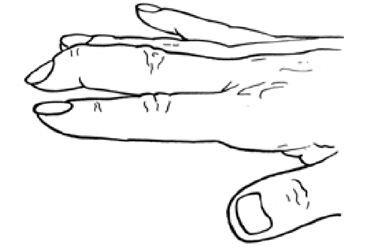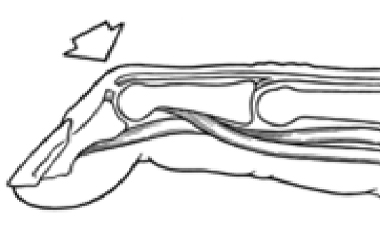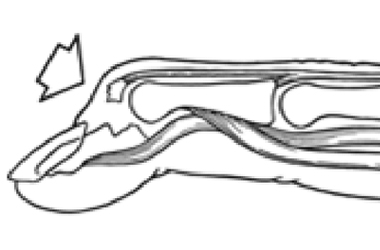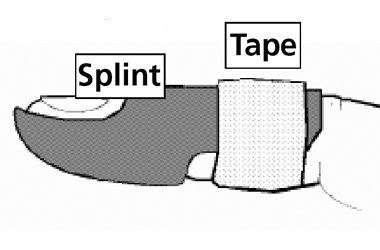Hand therapy
What is mallet finger?

Mallet finger is a common injury. It can occur in a number of ways, but most commonly when a straight finger is stubbed and forced to bend suddenly at the joint near the tip.
The tendon on the back of the joint snaps or pulls off its attachment to the bone. As a result you can no longer straighten the finger at this joint except by lifting it with the other hand. The finger adopts a dropped or mallet position.


Pain and swelling may also be present.
The mallet finger splint
The mallet finger splint is a simple splint and effective way to treat this injury. The splint is designed to keep the joint straight while the tendon heals.

When the joint is straight there is only a small gap between the ends of the tendon (or bone). Scar tissue froms in the gap and makes a snug repair.
Without the splint the finger drops, creating a large gap in the tendon. This leads to a slack repair and the finger remains in a dropped position. The splint should allow for movement at the middle joint.
Correct use of the splint
Treatment is most likely to succeed if the splint is:
- Always taped securely in place.
- Worn constantly day and night for a minimum of six to eight weeks
The splinted finger must be kept clean and dry at all times. If the skin becomes wet inside the splint it will become very sore. It is important to wash both your finger and the splint daily.
To wash the finger, gently rest the tip, palm side down, on the edge of the table or similar surface. Remove the tape and carefully slide the splint off. Wash the skin with soap and water, and then dry it thoroughly whilst fully supporting and never allowing the tip to bend.
When re-applying the splint support the tip of the finger on the table and keep the joint straight whilst you slide the splint back on. Secure the splint soundly with fresh tape.
What to expect when the splint is removed
Your hand therapist will check your finger at six weeks and if your tendon is able to straighten your finger well, you will be started on gradual exercises to regain the bend. If the finger is still dropped the splint will be kept on in place continuously for a further two weeks.
When the splint can come off for exercises, it is important to wear it overnight and during moderate use of the hand for at least a further two weeks.
It takes 12 weeks for your tendon to completely heal, so it is important to follow all advice to get the best result.
At first, when the splint is removed the finger may not bend easily at the joint which has been splinted. This is normal and will wear off gradually.
If the finger is perfectly straight, you will have an excellent result. Often it drops a little a day or two after the splint is removed. This will not cause any practical problems and can sometimes improve over a year or so.
The finger may be slightly red, swollen and sensitive to knocks for a number of months. It will settle down without treatment.
Do’s and don’ts
The splint is designed to interfere as little as possible with normal use of your hand.
Normal use will prevent stiffness of the uninjured parts of your finger and the rest of your hand. You can help to control the swelling in the injured finger by avoiding having your arm by your side for a long time.
You will be unable to return to work only if:
- The splint would infringe food safety regulations
- The splint would put you at risk of further injury on machinery.
- Your hands are constantly exposed to wet or very dirty conditions and you cannot protect them by wearing gloves.
When to contact for advice?
If you experience any of the following problems before your next review appointment
- The splint becomes too tight or too slack you cannot keep it on.
- You develop sores in the skin under the splint.
You should contact the hand therapy team on:
Patient experience
South Tees Hospitals NHS Foundation Trust would like your feedback. If you wish to share your experience about your care and treatment or on behalf of a patient, please contact The Patient Experience Department who will advise you on how best to do this.
This service is based at The James Cook University Hospital but also covers the Friarage Hospital in Northallerton, our community hospitals and community health services.
To ensure we meet your communication needs please inform the Patient Experience Department of any special requirements, for example braille or large print.
T: 01642 835964
E: [email protected]